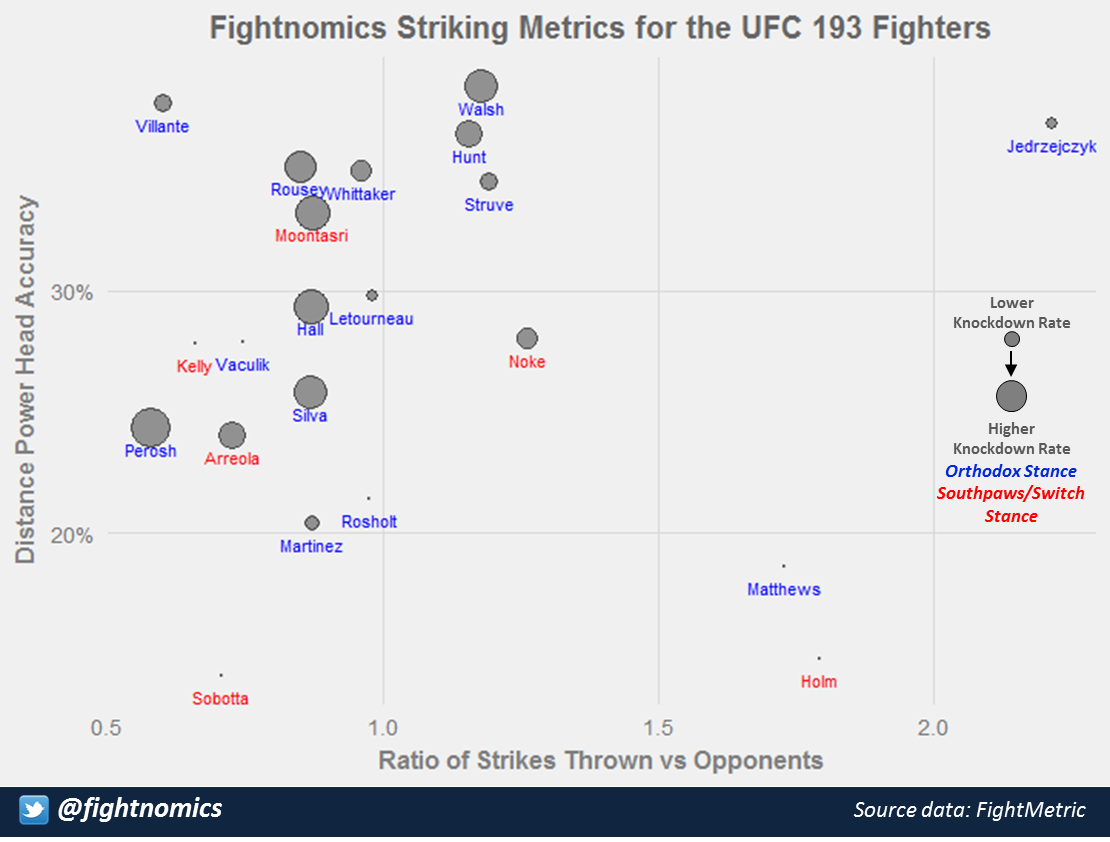By @fightnomics The final two fights at UFC 193 will feature two of the most decorated strikers in women’s MMA, one a former boxer, and one a form Muay Thai competitor. But one is a monstrous betting favorite, and the other is a massive underdog. One look at the graph below, and you’ll see why. But how does the rest of the card stack up in terms of striking skills? Let’s see them on all on page. How the Graph Works This balloon (or bubble) chart includes the fighters competing at UFC 193 with sufficient sample size. Many of them with move with more time, but it’s a good snapshot of how they’ve performed to date. The four metrics in the graph are all related to offensive striking. First, the vertical axis is the power head striking accuracy. This is a general reflection of a striker’s skill level in technique. But some fighters are more aggressive than others, while some are primarily counter-strikers, and those characteristics lead to very different striking styles. So the horizontal axis indicates the ratio of strike attempts while standing compared to the same fighter’s opponents. It’s a measure of output, and a proxy for aggression. An even 1.0 ratio means a guy matches the pace of his opponents when standing and trading, while a higher number shows more aggressive and higher-volume strikers compared to lower ratios indicating counter-strikers. The dots are plotted based on those two metrics, but two more variables are also shown. The size of the bubble is based on the fighter’s Knockdown Rate in the UFC/Strikeforce/WEC. Bigger bubbles mean a lot more power, while the small specks indicate fighters who haven’t logged a knockdown in recorded competition. And lastly, southpaw/switch stance strikers are in red. Lefties are rare, but are worth highlighting as most fighters have trouble with Southpaws.
For more on these and other MMA performance metrics, get the book “Fightnomics.”
Best in Class The latest breakout star in women’s MMA is Joanna Jedrzejczyk, champion of the newest UFC division, the Women’s Strawweights. Joanna is also the first Polish champion, and first female European champion – and all of this is due to her striking skills. Those skills have led to victory in over 100 bouts of Muay Thai, boxing, and kickboxing combined, making her one of the most experienced strikers in Women’s MMA, up there with the much more talked about Holly Holm. But on paper anyway, it’s Jedrzejczyk who is best in class in an MMA fight. She puts on a blistering striking pace, overwhelming her opponents while maintaining high precision in her volume and tight, technical defense in return. Compared to her opponent Letourneau, it would appear that Jedrzejczyk has striking advantages across the board, fueling the justification for her status as the heavy favorite. Snipers Out of the fighters with established sample size, former K-1 Kickboxer Mark Hunt has put his experience to good use in the cage, and his fists have found their target often with a power head strike accuracy of 37%. Gian Villante is just ahead of Hunt at 38%, but without a big a sample size, while Richard Walsh also has 37% with the smallest sample of that crew. Another Heavyweight to look out for is Stefan Struve, who also has a kickboxing base and the second longest wingspan in the UFC behind Jon Jones. He’ll be looking to put both of those to good use against the shorter wrestler Rosholt. High-Pressure Strikers In addition to Jedrzejczyk’s best in class aggression, there are two other fighters who likely to push a high pace against their opponents. The most aggressive strikers among this group are Holly Holm and Jake Matthews. Each has paid for their volume with lowered accuracy, but when you’re outpacing your opponents to such a degree, that may be okay. But each one is also facing a dangerous submission threat, so it will be interesting to see if they alter their usual game plan or continue to pour on the pace and take the risk. Another notable striking initiator is Kyle Noke, who appears to have a massive striking advantage over his opponent Peter Sabotta. If the fight stays standing, Noke will likely be in command of the fight. Sluggers The highest Knockdown Rate on the card will come as a big surprise: Anthony Perosh. Primarily a grappler, Perosh rarely lands his hands on opponents. But out of the 18 times that he did, twice he scored a knockdown, resulting in an abnormally high Knockdown Rate of 11%. Of the fighters with more time striking and more total knockdowns, consider Uriah Hall a massive threat with his hands, and more even more with his feet. The impressive striker now has three knockdowns in the UFC, not including his permanent-highlight-reel KO from The Ultimate Fighter. Other notables include Heavyweight Mark Hunt and Antonio Silva, who have scored six knockdowns each, and even Ronda Rousey who now has three. Keeping it on the Ground Not everyone can excel at striking, and there are a few fighters who have not performed well in any of these offensive striking categories. It doesn’t mean they’re destined for failure, it may just mean that their grappling-centric fighters, and their standup game is merely a set up for their ground game. That’s definitely true for Jared Rosholt and Peter Sabotta, who prefer to fight on the ground for different reasons. Rosholt is a former NCAA wrestler, who finds success when he gets opponents down and keeps them there. Sabotta is a submission specialist and BJJ black belt, who has taken 10 of his 15 career victories by submission, thanks in part to his esteemed trainer Dean Lister. For information on getting the “Fightnomics” the book, go here.

